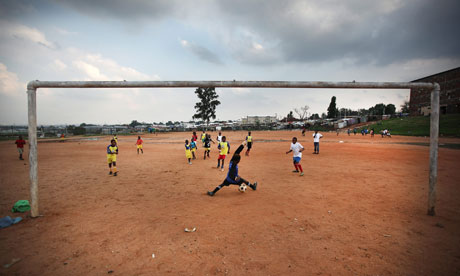
Photographer: Ilya Gridneff/Bloomberg
Huajian Chairman Zhang Huarong said, “Ethiopia is exactly like China 30 years ago.”
China, Africa and global retailers all have stakes in whether Ethiopia and such countries as Tanzania, Rwanda and Senegal become viable production bases for labor-intensive products. Promoting trade, boosting employment and spurring investment are among the topics that will be discussed on August 4-6 at the first White House
U.S.-Africa Leaders Summit in Washington.
African nations have a compelling opportunity to seize a share of the about 80 million jobs that China will export as its manufacturers lose competitiveness, according to
Justin Lin, a former World Bank chief economist who now is a professor of economics at Peking University.
‘Manufacturing Powerhouse’
Chinese Premier
Li Keqiang and Ethiopian Prime Minister
Hailemariam Desalegn, who met on May 4, backed the move of Chinese industries to Ethiopia. China is “supporting Ethiopia’s great vision to become Africa’s manufacturing powerhouse,” Hailemariam told reporters at a joint press conference in Addis Ababa.
Weaker consumer spending in the U.S. and Europe after the financial crisis prompted global retailers to hasten their search for lower-cost producers, said Helen Hai, head of China Africa Consulting Ltd. in Addis Ababa. She ran Huajian’s Ethiopia factory until July of last year.
While China’s inland regions offered manufacturers a cheaper alternative to the export-linked coastal areas, rising costs and a limited pool of available workers now are undermining that appeal.
Average factory pay in
Henan, about 800 kilometers from the coast, rose 103 percent in the five years ended in September and 80 percent in Chongqing, 1,700 kilometers up the Yangtze River. In the same period, salaries rose 82.5 percent in
Guangdong, where Huajian has its base in the city of Dongguan.
‘Great Potential’
Cost inflation in countries including China has prompted Hennes & Mauritz AB, Europe’s second-biggest clothing retailer, to work with three
suppliers in Ethiopia. The nation has “great potential” for production, H&M head of sustainability Helma Helmersson said in an April interview.
China’s average manufacturing wage is 3,469 yuan ($560) per month. Pay at the Huajian factory ranges from the basic after-tax minimum of $30 a month to about twice that for supervisors. By contrast, average
manufacturing wages in South Africa, Africa’s biggest manufacturer, are about $1,200.
The duty-free and quota-free access that Sub-Saharan Africa enjoys for the U.S. and EU markets gives additional savings thanks to the African Growth and Opportunity Act for the U.S. and the EU’s
Everything But Arms accord for the poorest countries. Import tariffs on shoes made in China range from 6 percent to as much as 36 percent, Zhang said.
Past-Future Business
A spokeswoman for Guess? confirmed that a licensee has done business with the Huajian Ethiopia factory in the past and may do so in the future.
A spokesman for Sycamore Partners, which owns Nine West, declined to comment on its business relationships and whether it has a relationship with Dongguan Huajian Shoes Industry Co. Marc Fisher Footwear is making shoes in the Ethiopia factory, Jaclyn Weissman, a spokeswoman for the company, wrote in an e-mail.
Signs of Ethiopia’s allure include factories outside Addis Ababa set up by
leather goods maker Pittards Plc of the U.K. and Turkish textile
manufacturer Ayka Tekstil. Foreign direct investment in the nation surged almost 250 percent to $953 million last year from the year before, according to estimates by the United Nations Conference on Trade and Development.
Zhang spends about half his time in Ethiopia, he says. During the visit last month, he spoke to about 200 uniformed Huajian supervisors, a mix of Ethiopians and Chinese, gathered in the parking lot. A giant plasma screen mirrored the crowd as Zhang hurried onto the stage.
Chant, March
He berated those assembled for a lack of efficiency, then praised them for their loyalty to Huajian, his words translated into Amharic and
Oromo. He ordered them to march on the spot, to turn left and to turn right, all chanting together in Chinese.
“One two one,” they chanted. “One two three four,” as they marched in step. Slogans followed: “Unite as one.” “Improvement together.” “Civilized and efficient.”
They sang the “Song of Huajian,” whose words urged “We Huajian people” to bravely move forward, to hold the banner of Huajian high and to “keep our business forever.” Chinese supervisors led the song, their Ethiopian colleagues stumbling over some words and struggling to keep up.
Later, Zhang explained that he can’t be as tough on the staff as he would like.
“Here the management cannot be too strong as there will be a problem with the culture,” he said via a translator. “In China you can be strong, but not here. The conditions here mean we have to show respect. On one hand we have to have strict requirements; on the other hand we have to take care of them. They have their own dignity. They may be poor but we have to respect their dignity.”
Labor Demands
About 200 of the workers rebelled in early 2013, going on strike for two days after demanding a share of profits following a period in which Huajian’s orders surged, said Hai. The incident was resolved with the help of Ethiopian labor officials, she said.
Five workers interviewed at the factory on July 10 described a workplace of strict standards, with rewards for good results and penalties such as docked pay for ruined shoes.
Taddelech Teshome, 24, said her day starts at 7:20 a.m. after her Chinese employers provide employees with a breakfast of bread and tea. When her morning shift ferrying shoes from the factory floor to the warehouse is over, she gets fed the national staple,
sour bread, for lunch. After work, a Huajian bus takes her to nearby Debre Zeit, a town where she rents a room with her sister for $18 a month.
Following Sister
She came to Huajian just over a year ago from her home 165 kilometers away in Arsi region after her sister started at the factory.
“The work is good because I pay my rent and I can look after myself,” she said, wearing an aqua Huajian polo shirt. “It’s transformed my life.” Taddelech said she wants to work for two more years at the plant and become a supervisor. She eventually aspires to build her own house.
With inflation at 8 percent -- down from 40 percent in July 2011 -– saving cash is tough. Mohammed al-Jaber, who earns $30 a month for gluing shoe linings eight hours a day six days a week, said he can add to his pay with perfect attendance each month -- a $7.50 bonus -- and overtime. Any extra gets sent home to his family in the Arsi region.
Once famine-plagued Ethiopia, run by former rebels since they overthrew a socialist military junta in 1991, is seeking investment to support a
growth rate that’s expected to fall to 7.5 percent this year from 9.7 percent in 2013. The population is expanding annually by 2.9 percent, at a time when the urban unemployment rate is 17.5 percent.
Economic Transformation
Ethiopia aims “to transform the economy” via industrialization by attracting foreign investors to zones where key public services will be concentrated, State Minister Of Finance Ahmed Shide said in an interview in Addis Ababa.
One appeal for China: Ethiopia follows a similar tightly controlled, state-heavy economic model. Opposition parties won only one out of 547 parliamentary seats at the last election in 2010.
Ties are strong between the Communist Party of China and the Ethiopian Peoples’ Revolutionary Democratic Front: On July 10, Central Committee Political Bureau member
Guo Jinlong visited Ethiopia and met with Prime Minister Hailemariam. The two
pledged to enhance cooperation, the official Xinhua news agency said.
Key Bottlenecks
Ethiopia’s heavy public investment in infrastructure using credit from Chinese state banks promises to relieve some key bottlenecks. The Export-Import Bank of China is funding a railway from Addis Ababa to landlocked Ethiopia’s main port in neighboring Djibouti. Ethiopia lost its coastline when Eritrea became independent in 1993.
The Chinese and Ethiopian governments also are investing in hydroelectric plants -- including what will be Africa’s largest, the domestically funded Grand Ethiopian Renaissance Dam on the Blue Nile -- that should increase Ethiopia’s power supply five-fold by 2020.
That may help overcome obstacles including the supply of electricity and cumbersome customs and tax procedures. In May, a World Bank team went to visit a textile factory in the Eastern Industrial Zone, where the Huajian plant is located, and found they are faced with daily power outages lasting for hours, Ethiopia country director Guang Zhe Chen said.
Sustainable Power
“There’s a big issue if you can’t ensure sustainable power supply for industrial zones,” he said.
While countries like Ethiopia have the potential to host Asian manufacturers, a “surge” hasn’t occurred, in part because of trade logistics constraints. “Getting things in and out of Ethiopia is very expensive and time consuming.”
Ethiopia
slipped one place to 125th in the World Bank’s 2014 Doing Business rankings for 189 economies. It was behind China, at 96th, and ahead of competitor Bangladesh, which ranked 130th, the Washington-based lender said on its website.
It’s easy to forget that China’s infrastructure also was rudimentary at a similar stage of development, said Lin. He recalls that the first time he made the 96-mile trip between Shenzhen and Guangzhou in southern China in the early 1980s it took more than 12 hours, including long waits for ferries to cross rivers. The same trip now can be done in two hours.
“There were no bridges,” Lin said in an interview.
Nor were workers accustomed to modern production techniques. When auto-parts maker Asimco Technologies Ltd. began manufacturing in China in the 1990s, workers weren’t responsive to training, said
Tim Clissold, former president of the Beijing-based company and author of a memoir,
“Mr. China.”
Smiling Politely
“It was very difficult to deliver improvements at individual factories,” he said. “You could do training, and everyone smiles politely and then continues doing what they were doing before.”
Now, rising Chinese wages that Zhang calls “an inevitable trend” are pushing Huajian to try to increase its workforce in Ethiopia to as many as 50,000 within eight years.
A model of a planned new plant at the edge of Addis Ababa is displayed at the factory. The 126-hectare (341-acre)
complex, partly financed by more than $300 million from Huajian, will include apartments for workers, a “forest resort” district and a technical university.
At the gathering in the parking lot, after supervisors sang Huajian’s company song, Zhang dismissed the Ethiopian contingent. Then he continued haranguing the Chinese managers. To make his point that structure was needed to keep employees in focus, he thrust a broomstick toward them repeatedly, then toward the remote camera that was feeding to the plasma screen, the image blurring with each prod.
Then he left the stage, laughing and raising a triumphant fist.












